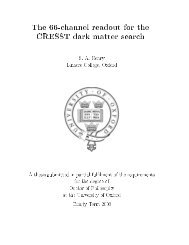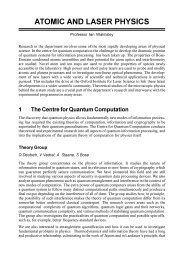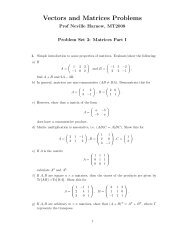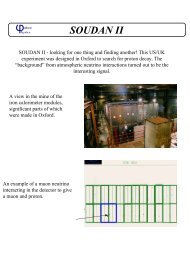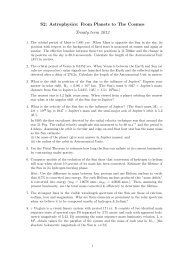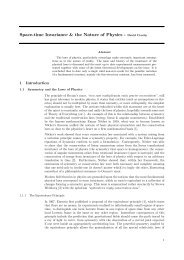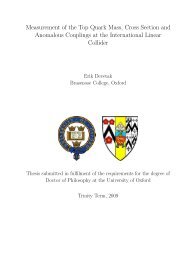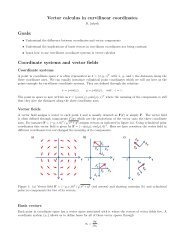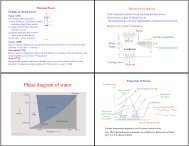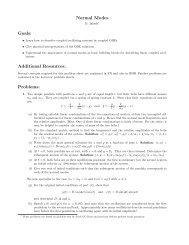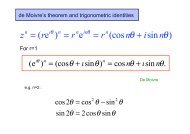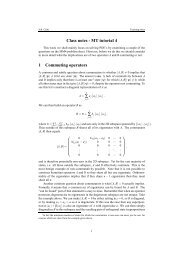Modern methods of acceleration and compact light sources
Modern methods of acceleration and compact light sources
Modern methods of acceleration and compact light sources
Create successful ePaper yourself
Turn your PDF publications into a flip-book with our unique Google optimized e-Paper software.
ACCELERATOR SCIENCE AND TRAINING –<br />
FUTURE DIRECTIONS<br />
MODERN METHODS OF ACCELERATION AND COMPACT<br />
LIGHT SOURCES<br />
Andrei A. Seryi<br />
John Adams Institute for Accelerator Science<br />
University <strong>of</strong> Oxford <strong>and</strong> Royal Holloway University <strong>of</strong> London, UK<br />
Particle Physics seminar<br />
9 th November 2010
Uncovering the origin <strong>of</strong> the universe<br />
Big Bang<br />
now<br />
Older ….. larger … colder ….less energetic<br />
A. Seryi, 9 th Nov 2010<br />
2
Colliders – explore what matter is made <strong>of</strong><br />
The hottest spots in the galaxy<br />
When the two beams <strong>of</strong> protons<br />
collide, they will generate<br />
temperatures<br />
1000 million times hotter<br />
than the heart <strong>of</strong> the sun,<br />
but in a minuscule space<br />
A. Seryi, 9 th Nov 2010
“Yesterday”<br />
LEP Collider, CERN<br />
SLAC Linear Collider<br />
“Today”<br />
VEP-2000 Collider, BINP<br />
Tevatron collider, Fermilab<br />
A. Seryi, 9 th Nov 2010
Precision measurements at CERN/LEP <strong>and</strong><br />
SLAC/SLC establish St<strong>and</strong>ard Model – explains<br />
how particles interact …<br />
But pr<strong>of</strong>ound<br />
question remain<br />
• Why do the particles all<br />
have different masses,<br />
<strong>and</strong> where does the mass<br />
come from?<br />
What causes mass??<br />
The mechanism – Higgs or<br />
alternative appears around<br />
the corner<br />
A. Seryi, 9 th Nov 2010
Composition <strong>of</strong> the universe<br />
Known <strong>and</strong> Understood<br />
Matter<br />
Unknown Matter ~ 90%<br />
DARK MATTER &<br />
DARK ENERGY<br />
What is Dark Matter ?<br />
• Perhaps a new form <strong>of</strong> elementary particle?<br />
A. Seryi, 9 th Nov 2010
Supersymmetry <strong>and</strong> Dark Matter<br />
• Just as with anti-matter, new particles are predicted<br />
• Supersymmetric particles have just the properties expected <strong>of</strong><br />
Dark Matter<br />
A. Seryi, 9 th Nov 2010
Large Hadron Collider<br />
Proton beam stores 700 MegaJoules equivalent to Boeing<br />
747 energy on take-<strong>of</strong>f – enough to melt 1/2 ton copper<br />
A. Seryi, 9 th Nov 2010
A. Seryi, 9 th Nov 2010<br />
The Biggest Detectors ever built
LHC <strong>and</strong> e + e - Collider<br />
LHC will open the curtain<br />
<strong>of</strong> a theatre <strong>of</strong> new physics<br />
Proton is a composite object –<br />
complex analysis<br />
Electron <strong>and</strong> positron are zero-size<br />
objects<br />
The e+e- collider will<br />
illuminate the stage<br />
A. Seryi, 9 th Nov 2010
A. Seryi, 9 th Nov 2010<br />
Comparative accuracy <strong>of</strong> particle physics<br />
“microscopes”
Designing the next Linear<br />
Collider<br />
few GeV<br />
pre-accelerator<br />
source<br />
KeV<br />
damping<br />
ring<br />
few GeV<br />
few GeV<br />
250-500 GeV<br />
final focus<br />
extraction<br />
& dump<br />
bunch<br />
compressor<br />
main linac<br />
collimation<br />
IP<br />
A. Seryi, 9 th Nov 2010
International Linear Collider<br />
Developed by Global Design Effort (GDE)<br />
A. Seryi, 9 th Nov 2010
A. Seryi, 9 th Nov 2010<br />
ILC’s Workhorse – Superconducting RF
CLIC – Compact Linear<br />
Collider<br />
Alternative design that may provide path to higher energy<br />
Undergoing active design <strong>and</strong> feasibility study<br />
A. Seryi, 9 th Nov 2010
Accelerator-Driven Subcritical<br />
Reactor (ADSR)<br />
A. Seryi, 9 th Nov 2010<br />
Concept<br />
Superconducting cavities<br />
– key for enabling ADSR<br />
Accelerators can drive next-generation reactors<br />
that burn non-fissile fuel, such as thorium<br />
Dominant feature <strong>of</strong> ADSR – its inherent safety
Accelerators Worldwide<br />
• High-energy accelerators 120<br />
• Synchrotron radiation X-ray <strong>sources</strong> 100<br />
• Radiotherapy 7700<br />
• Biomedical research 1000<br />
• Industrial processing 1500<br />
• Ion implanters, surface modification 7000<br />
Total 17,500<br />
Accelerators are not only for high energy physics<br />
A. Seryi, 9 th Nov 2010
Diamond: synchrotron source <strong>of</strong> X-rays<br />
Diamond Light Source, Harwell Science <strong>and</strong> Innovation Campus, UK<br />
A. Seryi, 9 th Nov 2010
Protein structure revealed with<br />
help <strong>of</strong> <strong>light</strong> <strong>sources</strong><br />
HIV glycoprotein<br />
mosquito<br />
immune system<br />
yeast enzyme<br />
A. Seryi, 9 th Nov 2010
Radiotherapy with X-rays<br />
A. Seryi, 9 th Nov 2010
Cancer therapy with protons<br />
protons deposit energy much<br />
more selectively than x-rays<br />
PAMELA: Particle Accelerator for MEdicaL<br />
Applications<br />
Accelerator for cancer therapy designed<br />
by collaboration <strong>of</strong> UK institutions<br />
A. Seryi, 9 th Nov 2010
ISIS: neutron <strong>and</strong> muon source<br />
ISIS pulsed neutron <strong>and</strong> muon source at the<br />
Rutherford Appleton Laboratory, UK<br />
A. Seryi, 9 th Nov 2010
Neutrons <strong>and</strong> muons imaging<br />
is essential for development <strong>of</strong><br />
advanced materials for energy,<br />
nanotechnology, etc<br />
Materials with low-dimensional<br />
structures (e.g. 2-D or layered<br />
materials such as graphene) have<br />
been studies by combination <strong>of</strong><br />
neutron scattering <strong>and</strong> x-ray<br />
diffraction... [A Goodwin (Cambridge Univ.) A<br />
Hannon (ISIS), et al]<br />
October 5, 2010:<br />
Andre Geim <strong>and</strong> Konstantin Novoselov from the University <strong>of</strong><br />
Manchester have been awarded this year's Nobel Prize in Physics<br />
following their pioneering research on Graphene<br />
A. Seryi, 9 th Nov 2010
Accelerators <strong>and</strong> Nobel<br />
Recent studies by Alex<strong>and</strong>er W. Chao <strong>and</strong> Enzo F. Haussecker<br />
(SLAC) have shown that<br />
The fraction <strong>of</strong> the Nobel prizes in Physics directly<br />
connected to accelerators is very close to 30%<br />
A.Chao <strong>and</strong> E. Haussecker "Impact <strong>of</strong> Accelerator Science on<br />
Physics Research", to be published in International Committee <strong>of</strong> Future<br />
Accelerators Beam Dynamics Newsletter, December 2010; <strong>and</strong> submitted to<br />
the Physics in Perspective Journal, December 2010.<br />
A. Seryi, 9 th Nov 2010
Atsuto Suzuki (KEK), chair <strong>of</strong> ICFA (International Committee for Future Accelerators)<br />
A. Seryi, 9 th Nov 2010
Atsuto Suzuki (KEK), chair <strong>of</strong> ICFA (International Committee for Future Accelerators)<br />
A. Seryi, 9 th Nov 2010
Atsuto Suzuki (KEK), chair <strong>of</strong> ICFA (International Committee for Future Accelerators)<br />
A. Seryi, 9 th Nov 2010
Concept <strong>of</strong> a<br />
Plasma Wake-Field Acceleration<br />
Electron/Positron Linear Collider<br />
3D-PIC PWFA simulation by F. Tsung/UCLA<br />
(CERN Courier June 2007, P.28, C. Joshi)
A. Seryi, 9 th Nov 2010<br />
While such direct extrapolation<br />
is not valid, the synergy <strong>of</strong><br />
classic accelerators <strong>and</strong> laser<br />
<strong>and</strong> plasma based will clearly<br />
change the entire l<strong>and</strong>scape <strong>of</strong><br />
accelerator science
Recent tremendous progress in plasma <strong>acceleration</strong><br />
42 GeV<br />
85GeV<br />
A. Seryi, 9 th Nov 2010<br />
Nature v 445,p741 (2007)<br />
Energy Doubling <strong>of</strong> 42<br />
Billion Volt Electrons Using<br />
an 85 cm Long Plasma<br />
Wakefield Accelerator
Experiments at FFTB<br />
demonstrated 50GeV/m<br />
FFT experiments had single bunch<br />
Two bunches: drive <strong>and</strong> witness, will<br />
provide high efficiency <strong>of</strong> E transfer<br />
to accelerated bunch<br />
A. Seryi, 9 th Nov 2010
A concept for Plasma Wake Field Acceleration<br />
1TeV CM Linear Collider<br />
Combines breakthrough performance <strong>of</strong> plasma <strong>acceleration</strong> &<br />
wealth <strong>of</strong> 30+ yrs <strong>of</strong> LC development<br />
RF gun<br />
Drive beam accelerator<br />
bunch compressor<br />
RF separator<br />
Drive beam distribution<br />
Beam Delivery <strong>and</strong> IR<br />
PWFA cells<br />
PWFA cells<br />
FACET address<br />
key issues <strong>of</strong><br />
single stage<br />
DR e- main beam e-<br />
main beam<br />
injector<br />
DR e+<br />
e+ injector<br />
A. Seryi, 9 th Nov 2010
Key features <strong>of</strong> PWFA-LC concept<br />
Electron drive beam for both electrons <strong>and</strong> positrons<br />
High current low gradient efficient 25GeV drive linac<br />
similar to linac <strong>of</strong> CERN CTF3, demonstrated performance<br />
Multiple plasma cells<br />
20 cells, meter long, 25GeV/cell, 35% energy transfer efficiency<br />
Main / drive bunches<br />
2.9E10 / 1E10<br />
A. Seryi, 9 th Nov 2010
Drive beam distribution<br />
Single train for e+ <strong>and</strong> e- sides<br />
Separation by RF deflectors<br />
Kickers<br />
mini-train 1 2.9E10 e-/bunch mini-train 20<br />
500ns<br />
2*125 bunches<br />
100ns<br />
kicker gap<br />
12µs train<br />
feedforward<br />
Kickers with ~100ns rise time<br />
Possibility for feed-forward<br />
Plasma cell spacing c*600ns/2<br />
main beam<br />
animation <strong>of</strong> beam drive distribution:<br />
A. Seryi, 9 th Nov 2010
Accelerator Science Facilities<br />
(few examples, not a comprehensive review)<br />
National Lab scale facilities<br />
FACET (SLAC, USA)<br />
Acc. Facility at FNAL (USA)<br />
ATF/ATF2 (KEK, Japan)<br />
ALICE/EMMA (Daresbury, UK)<br />
...<br />
University scale facilities<br />
A. Seryi, 9 th Nov 2010
FACET<br />
FACILITY FOR ADVANCED ACCELERATOR<br />
EXPERIMENTAL TESTS AT SLAC
Unique properties <strong>of</strong> SLAC e+ <strong>and</strong> e- beams (ultra-short, high<br />
charge) provide worldwide unique opportunities for accelerator<br />
research at FACET<br />
Constructed with funds provided by American Recovery <strong>and</strong> Reinvestment Act
Two electron<br />
bunches formed by<br />
notch collimator will<br />
allow study energy<br />
doubling, high<br />
efficiency<br />
<strong>acceleration</strong>,<br />
emittance<br />
preservation
R 56 = 4 mm, ∆s = 52.7 mm<br />
e+ upgrade<br />
Shared linac e+ sailboat e+ Shared FF<br />
chicane<br />
IP<br />
e- e-<br />
e- σ x = σ y<br />
R 56 = 4 mm η = 0<br />
64 m<br />
“Sailboat” dual chicane will give unique opportunity to study<br />
<strong>acceleration</strong> <strong>of</strong> positrons by an electron bunch
e -<br />
e +<br />
Focal Point:<br />
∆z = -0.1mm<br />
RF<br />
e +<br />
e -<br />
∆z = 5 cm<br />
“Sailboat” dual chicane will give unique opportunity to study<br />
<strong>acceleration</strong> <strong>of</strong> positrons by an electron bunch
Unique science opportunities for variety <strong>of</strong> fields:<br />
Plasma beam source<br />
Plasma lens for <strong>compact</strong> focusing<br />
Bent crystal for beam collimation or photon source<br />
e+ <strong>and</strong> e- <strong>acceleration</strong> study essential for LWFA & PWFA<br />
Dielectric wakefield <strong>acceleration</strong><br />
Energy-doubling for existing facilities such as FEL’s<br />
Generation <strong>of</strong> THz radiation for materials studies
Short bunches <strong>and</strong> their Tera-Hz radiation open new<br />
possibilities to study ultrafast magnetization switching
New stair case<br />
in S19<br />
Sector 20<br />
Bunch compressor, final focus,<br />
experimental area <strong>and</strong> beam dump<br />
Sector 10<br />
bunch<br />
compressor<br />
Experimental area &<br />
instrumentation<br />
A. Seryi, 9 th Nov 2010
FACET parameters for Science<br />
Energy<br />
Charge per pulse<br />
Pulse length at IP (σ z )<br />
Typical spot size at IP (σ x,y ) 10 to 20 µm<br />
Repetition rate<br />
23 GeV with full compression <strong>and</strong><br />
maximum peak current<br />
2 x 10 10 (3 nC) e - or e + per pulse with full<br />
compression<br />
25 µm with 4 % FW momentum spread<br />
with full compression <strong>and</strong><br />
40 µm with 1.5 % FW momentum spread<br />
with partial compression<br />
30 Hz<br />
Momentum spread 4 % FW with full compression (3 %<br />
FWHM);
Fermilab Acc Science facility<br />
S. Nagaitsev et al<br />
• Low energy beamlines:<br />
–40 MeV (gun, two 9-cell cavities)<br />
• High energy beamlines:<br />
–810 MeV (3 cryomodules);<br />
–1075 MeV (4 cryomodules);<br />
–1500 MeV (6 cryomodules),<br />
• Space for a 10 m storage ring<br />
Constructed with funds provided by American Recovery <strong>and</strong> Reinvestment Act<br />
A. Seryi, 9 th Nov 2010
Fermilab Acc Science facility<br />
Proposals<br />
Emittance exchange<br />
Optical stochastic cooling<br />
Plasma <strong>acceleration</strong><br />
Integrable optics ring, etc<br />
S. Nagaitsev et al<br />
A. Seryi, 9 th Nov 2010
A. Seryi, 9 th Nov 2010<br />
ATF / ATF2 facility at KEK
A. Seryi, 9 th Nov 2010<br />
ATF till 2008
ATF2: 2009-<br />
A. Seryi, 9 th Nov 2010<br />
Prototype linear collider final focus system<br />
Aim to focus 1.3 GeV beam to 37nm<br />
Equivalent to 2.7 nm at 250 GeV/beam
ATF International organization is defined by MOU signed by 25 institutions<br />
One <strong>of</strong> the missions <strong>of</strong> ATF <strong>and</strong> ATF2, is to provide the young scientists <strong>and</strong><br />
engineers with training opportunities <strong>of</strong> participating in R&D programs for<br />
advanced accelerator technologies<br />
As <strong>of</strong> May 2010, six PhD in Accelerator Science based on ATF2 work <strong>and</strong><br />
another eight PhD studies are in development<br />
A. Seryi, 9 th Nov 2010
ATF2 beyond 2012<br />
A new element <strong>of</strong> research programme<br />
Physics in ultra intense laser field<br />
A. Seryi, 9 th Nov 2010<br />
T.Tauchi et al
Facilities at KEK<br />
Nanometer electron beam at ATF2<br />
1.3GeV energy<br />
37nm vertical beam size at IP<br />
Analogy between Hawking <strong>and</strong><br />
Unruh radiation (P. Chen) <strong>and</strong><br />
scheme <strong>of</strong> detecting Unruh radiation<br />
A. Seryi, 9 th Nov 2010<br />
Ultra-intense Laser beam in future<br />
λ = 0.8 um<br />
intensity >10 20 W/cm 2<br />
Acceleration (a 0 ωc)=3.4x10 25 m/s 2<br />
T.Tauchi et al
Accelerators <strong>and</strong> Lasers In Combined Experiments (ALICE)<br />
Electron Model for Many Applications (EMMA) at Daresbury Lab<br />
e- 30 MeV; Compton x-ray to 30keV; energy recovery; FFAG tests<br />
R Barlow et al. / Nuclear Instruments <strong>and</strong> Methods in Physics Research A 624 (2010) 1–19<br />
A. Seryi, 9 th Nov 2010<br />
Jim Clarke, Susan Smith, et al
ALPHA-X project at Univ. <strong>of</strong> Strathclyde<br />
Advanced Laser Plasma<br />
High-energy Accelerators<br />
towards X-rays<br />
Recently achievements:<br />
<br />
<br />
Energy spread:<br />
<br />
A. Seryi, 9 th Nov 2010<br />
< 0.4% @ 100 MeV<br />
Emittance: < 1 πmm mrad<br />
Energy stability 2.8%<br />
<br />
<br />
<br />
<br />
<br />
Energy range:<br />
<br />
<br />
20 –200 MeV –gas jet<br />
up to 0.8 GeV–capillary<br />
Bunch duration: 1 fs<br />
Charge: 1 –100 pC<br />
Peak current: > 5 kA<br />
Pointing stability: ≈ ±1 mrad<br />
Dino Jaroszynski
A. Seryi, 9 th Nov 2010<br />
8 November 2010 Google image<br />
115th Anniversary <strong>of</strong> the Discovery <strong>of</strong> X-rays
A. Seryi, 9 th Nov 2010<br />
Diamond beamlines
New Light Source design<br />
Jon Marangos et al<br />
A. Seryi, 9 th Nov 2010
LCLS at SLAC<br />
A. Seryi, 9 th Nov 2010
Compact Light Sources<br />
A. Seryi, 9 th Nov 2010
Compton scattering<br />
Inverse Compton scattering:<br />
photon gains energy after interaction<br />
e- γmc 2 λ 1<br />
λ 2 = λ 1 ( 1+θ 2 γ 2 ) / ( 4γ 2 )<br />
λ 2<br />
θ<br />
Examples for λ 1 = 532 nm (2.33 eV)<br />
<br />
<br />
e- 5.11 MeV (γ =10), λ 2 = 1.33 nm (0.93 keV)<br />
e- 18.6 MeV (γ =36.5), λ 2 = 0.1 nm (12.4 keV)<br />
A. Seryi, 9 th Nov 2010
Evolution <strong>of</strong> computers<br />
<strong>and</strong> <strong>light</strong> <strong>sources</strong><br />
A. Seryi, 9 th Nov 2010
A. Seryi, 9 th Nov 2010<br />
THOMX Conceptual Design Report, A.Variola, A.Loulergue,<br />
F.Zomer, LAL RT 09/28, SOLEIL/SOU-RA-2678, 2010
Lyncean Technologies, Inc.<br />
Compact X-ray <strong>light</strong> source<br />
25 MeV accelerator<br />
X-ray tuneable from a few keV up to 35 keV<br />
Fits in a 10x25 ft room<br />
Clinical High Resolution Imaging System<br />
Micro-tomography<br />
Protein crystallography<br />
A. Seryi, 9 th Nov 2010<br />
Hard X-ray phase-contrast imaging with the Compact<br />
Light Source based on inverse Compton X-rays, M.<br />
Bech, O. Bunk, C. David, R. Ruth, J. Rifkin, R. Loewen,<br />
R. Feidenhans'l <strong>and</strong> F. Pfeiffer<br />
et al, J. Synchrotron Rad. (2009). 16, 43-47
A. Seryi, 9 th Nov 2010<br />
R. Ruth, SLAC / Lyncean Technologies
THOMX – Compton source<br />
X-ray energy 50-90 keV<br />
Flux 1E11-1E13 ph/s<br />
Ring energy 50 MeV<br />
Scientific case<br />
Cultural heritage application<br />
Bio-Medical applications<br />
X-ray crystallography<br />
A.Variola, A.Loulergue, F.Zomer,<br />
LAL RT 09/28, SOLEIL/SOU-RA-<br />
2678, 2010<br />
A. Seryi, 9 th Nov 2010
Mono-Energetic Gamma-Ray (MEGa-Ray) Compton<br />
<strong>light</strong> source (LLNL & SLAC)<br />
Nuclear resonance fluorescence<br />
Isotopic sensitivity<br />
A. Seryi, 9 th Nov 2010<br />
F.V. Hartemann (LLNL) et al, ICFA FLS 2010
Compton ring for nuclear waste management<br />
E. Bulyak, J. Urakawa, et al., Nucl. Instr. <strong>and</strong> Meth. A<br />
(2010), doi:10.1016/j.nima.2010.06.215<br />
• Intense gamma-ray source<br />
• Gamma-ray energies in the range from 1 to 5 MeV.<br />
• Detect practically all <strong>of</strong> the isotopes present in nuclear waste, based on nuclear<br />
resonance fluorescence method –suitable for express nuclear waste management<br />
• Crab-crossing scheme helps to reach gamma-beam intensity <strong>of</strong> up to 5E13 γ/s<br />
A. Seryi, 9 th Nov 2010
Laser Undulator Compact X-ray Source Facility (LUCX) at the<br />
Accelerator Test Facility (ATF), KEK<br />
50 MeV beam, trains with 100 bunches,<br />
bunch spacing <strong>of</strong> 2.8 ns,<br />
a maximum total charge <strong>of</strong> 250 nC<br />
multi-bunch electron linac mode-locked<br />
1064 nm laser<br />
Flux 1.2E5 photons/s<br />
A first step toward “Quantum beam project”<br />
Development <strong>of</strong> a <strong>compact</strong> X-ray source based on Compton scattering using a<br />
1.3 GHz superconducting RF accelerating linac <strong>and</strong> a new laser storage cavity, J.<br />
Urakawa, Nucl. Instr. <strong>and</strong> Meth. A (2010), doi:10.1016/j.nima.2010.02.019<br />
A. Seryi, 9 th Nov 2010
S-b<strong>and</strong> linac-based X-ray source<br />
S-b<strong>and</strong> linac-based X-ray source with p/2-mode<br />
electron linac, A. Deshp<strong>and</strong>e, et al., Nucl. Instr. <strong>and</strong><br />
Meth. A (2010), doi:10.1016/j.nima.2010.02.023<br />
KEK- SAMEER (India) collaboration<br />
Side-coupled linac tube built at SAMEER, Society<br />
for Applied Microwave Electronic Engineering <strong>and</strong><br />
Research (SAMEER), India<br />
Aiming to develop a low-cost, high- performance tuneable X-ray source very useful for<br />
small research groups, small industry setups, <strong>and</strong> hospitals<br />
A. Seryi, 9 th Nov 2010
Compact coherent Compton EUV source<br />
<br />
<br />
Extreme ultra-violet (EUV) lithography at λ=13.5nm – strongest c<strong>and</strong>idate<br />
<strong>of</strong> the next generation processing <strong>of</strong> Large Scale Integration circuits<br />
FEL schemes are possible, but require ~GeV scale facilities<br />
Compact EUV source based on a laser Compton scattering between a 7<br />
MeV micro-bunched electron beam <strong>and</strong> a high-intensity CO2 laser pulse<br />
<br />
Severe condition for the average current <strong>and</strong> the optical undulator length<br />
may be eased by use <strong>of</strong> coherent effect, when the pre-bunched beam is<br />
applied to the laser Compton scheme<br />
S. Kashiwagi et al. / Radiation Physics <strong>and</strong> Chemistry 78 (2009) 1112–1115<br />
A. Seryi, 9 th Nov 2010
Compton X-ray source at Univ. <strong>of</strong> Tokyo<br />
<br />
<br />
<br />
<br />
<br />
X-rays 10–40 keV for medical science,<br />
biology, <strong>and</strong> materials science<br />
Multi-bunch electron beam <strong>and</strong> a longpulse<br />
laser for higher flux<br />
<br />
<br />
Electron beam: 200 mA peak & 2 mA average<br />
under 10 Hz operation, multi-bunch (10 4<br />
bunches in 1 ms)<br />
Laser: energy 1.4 J, duration 10 ns at a<br />
wavelength <strong>of</strong> 532 nm.<br />
30 MeV X-b<strong>and</strong> (11.424 GHz) linac<br />
3.5-cell thermionic cathode RF-gun<br />
Have demonstrated the 2MeV electron<br />
beam generation from the RF-gun<br />
F. Sakamoto et al, Nuclear Instruments <strong>and</strong> Methods in<br />
Physics Research A 608 (2009) S36–S40<br />
A. Seryi, 9 th Nov 2010
PEGASUS @ UCLA<br />
(Photoelectron Generated Amplified Spontaneous Radiation Source)<br />
Small university-size accelerator<br />
A. Seryi, 9 th Nov 2010<br />
1.6 cell S-b<strong>and</strong> photocathode gun<br />
located in the sub-basement <strong>of</strong> Knudsen Hall in the UCLA Department <strong>of</strong><br />
Physics <strong>and</strong> Astronomy<br />
Research in ultrafast beams, advanced beam<br />
manipulation <strong>and</strong> diagnostics techniques.<br />
J.B. Rosenzweig, et al<br />
Novel beam instrumentation, RF photo-injectors,<br />
ultrafast relativistic electron diffraction
PEGASUS @ UCLA<br />
Ultrafast relativistic electron diffraction<br />
Real time resolution <strong>of</strong> atomic motion<br />
Pulse length (100fs) comparable to time-scale <strong>of</strong> atomic<br />
<strong>and</strong> molecular motion<br />
De Broglie wavelength λ = h/p ~ 0.3 pm (for e- @ 5 MeV)<br />
Ultra relativistic beam easier to h<strong>and</strong>le space charge,<br />
larger bunch population <strong>and</strong> shorter bunch<br />
MeV electron diffraction<br />
from 200 nm Titanium foil<br />
J.B. Rosenzweig, et al<br />
A. Seryi, 9 th Nov 2010
PEGASUS @ UCLA<br />
<br />
Ultrafast relativistic electron<br />
diffraction<br />
Real time resolution <strong>of</strong><br />
atomic motion<br />
RF streak camera approach<br />
true single-shot structural<br />
change studies<br />
Demonstration <strong>of</strong> sub 100fs<br />
time resolution<br />
<br />
5 fs time resolution possible<br />
RF streak camera based ultrafast relativistic electron diffraction, P. Musumeci, et al, Rev. Sci.<br />
Instr. 80, 013302 2009<br />
A. Seryi, 9 th Nov 2010<br />
Time dependence <strong>of</strong> the position <strong>of</strong> the Al 111<br />
Bragg diffraction peak for beam with energy chirp
Tsinghua Univ Thomson scattering X-ray source<br />
Recently demonstrated single shot continuously timeresolved<br />
mode <strong>of</strong> operation for ultrafast electron diffraction<br />
A. Seryi, 9 th Nov 2010<br />
Renkai Li, et al, Rev. Sci. Instr. 80, 083303 (2009)
S<strong>of</strong>t X-ray or THz source based on<br />
Coherent Diffraction Radiation<br />
LUCX facility at KEK<br />
Intensity depends on bunch population as N 3<br />
No need <strong>of</strong> a laser in this scheme<br />
A COMPACT SOFT X-RAY SOURCE BASED ON THOMSON SCATTERING OF COHERENT<br />
DIFFRACTION RADIATION, A. Aryshev et al, KEK, JAI, NPI Tomsk, Waseda Univ., PAC2010<br />
A. Seryi, 9 th Nov 2010
Quantum beam project Characteristic <strong>of</strong> proposed machine<br />
Compact (less than 10m) quasi-monochromatic (less than 1%)<br />
High Flux ( 100 times than Compact normal Linac X-ray:10 11 photons/sec 1% b.w.)<br />
High Brightness (10 17 photons/sec mrad 2 mm 2 0.1% b.w.)<br />
Ultra-short pulse X-ray (40 fs ~)<br />
J. Urakawa, Quantum Beam Project<br />
Key technology is<br />
SCRF <strong>acceleration</strong> technology<br />
Structural Nano-material Highly fine<br />
genetic analysis, evaluation, X-ray Imaging<br />
A. Seryi, 9 th Nov 2010<br />
77<br />
http://mml.k.u-tokyo.ac.jp/
A. Seryi, 9 th Nov 2010<br />
J. Urakawa, Nucl. Instr. <strong>and</strong> Meth. A (2010), doi:10.1016/j.nima.2010.02.019
High-Intensity Compact X-ray Source<br />
A. Seryi, 9 th Nov 2010<br />
J. Urakawa, et al, Quantum Beam Project
High-Intensity Compact X-ray Source<br />
technology Present status Target Key points<br />
Electron<br />
source<br />
300 nC/pulse<br />
10,000nC/pulse<br />
(2008-2009)<br />
48,000 nC/pulse<br />
(2010-2012)<br />
Pulse laser, new photocathode,<br />
1 msec pulse<br />
length<br />
SC Cavity<br />
Pulsed laser<br />
storage<br />
Pulse: 25 MV/m<br />
CW: 12 MV/m<br />
Pulse: 30 MV/m<br />
CW: 20 MV/m<br />
Non-defect <strong>and</strong> clean<br />
surface, Precise electron<br />
beam welding, High<br />
precision forming, Noncontamination<br />
material<br />
0.5 mJ/pulse,<br />
Waist: 30 µm<br />
50 mJ/pulse,<br />
Waist: 8 µm<br />
4-mirror optical cavity<br />
Colliding<br />
control<br />
µm beam orbit<br />
control<br />
Sub- µm beam<br />
orbit control<br />
minimizing<br />
environmental effect,<br />
Fast feedback control<br />
A. Seryi, 9 th Nov 2010<br />
J. Urakawa, et al, Quantum Beam Project
Quantum beam Organization & Responsibility<br />
Compact <strong>and</strong> reliable Multi-beam Klystron R&D<br />
Committee for project<br />
evaluation<br />
High powwer RF<br />
Toshiba<br />
Compact Klystron<br />
Hiroshima U.<br />
Laser storage<br />
RF Gun<br />
Photo-cathode<br />
Main Institute<br />
KEK<br />
SC RF Accelerator development<br />
High stablle HV PS<br />
Hitachi<br />
DC High Voltage Source<br />
System design, Operation, Performance<br />
High stablle HV PS<br />
Measurement<br />
Education for young sientists<br />
Pullsed Laser Storage<br />
ATF, STF<br />
JAEA<br />
DC High Voltage PS<br />
High Quality <strong>and</strong> Intensity e- sourcePhoto-Cathode<br />
ERL Electron Source Device<br />
Waseda U.<br />
X-ray detector<br />
Laser Compton Exp.<br />
Compact Accelerator<br />
U. <strong>of</strong> Tokyo<br />
Photo-cathode<br />
Input coupler<br />
A. Seryi, 9 th Nov 2010<br />
J. Urakawa, et al, Quantum Beam Project
SRF Compact Light Sources @ 4K<br />
• Most existing SRF cavities require or benefit from 2K operation<br />
– Too complex for a University or small institution-based accelerator<br />
– Cryogenics is a strong cost driver for <strong>compact</strong> SRF linacs<br />
• Spoke cavities can operate at lower frequency<br />
– Lower frequency allows operation at 4K<br />
– No sub-atmospheric cryogenic system<br />
– Significant reduction in complexity<br />
Jean Delayen<br />
Center for Accelerator Science Old Dominion University<br />
And Thomas Jefferson National Accelerator Facility<br />
A. Seryi, 9 th Nov 2010
SRF Compact Light Sources @ 4K<br />
Superconducting<br />
RF photoinjector<br />
operating at 300<br />
MHz <strong>and</strong> 4K<br />
RF amplifiers<br />
RF amp RF amp RF amp<br />
Bunch compression chicane<br />
Inverse Compton<br />
scattering<br />
30 kW beam<br />
dump<br />
1 MeV<br />
Electron beam <strong>of</strong> ~1 mA average<br />
current at 10-30 MeV<br />
8 m<br />
30 MeV<br />
Coherent enhancement<br />
cavity with Q=1000 giving<br />
5 MW cavity power<br />
5 kW cryo-cooled<br />
Yb:YAG drive<br />
laser<br />
X-ray<br />
beamline<br />
MIT CUBIX proposal<br />
Multi-institutional<br />
collaboration<br />
SRF Linac Parameters<br />
Energy gain [MeV] 25<br />
RF frequency [MHz] 352<br />
Average current [mA] 1<br />
Operating temperature [K] 4.2<br />
RF power [kW] 30<br />
Jean Delayen Center for Accelerator<br />
Science Old Dominion University <strong>and</strong> Thomas<br />
Jefferson National Accelerator Facility<br />
A. Seryi, 9 th Nov 2010<br />
W.S. Graves et al. / Nuclear Instruments <strong>and</strong> Methods in<br />
Physics Research A 608 (2009) S103–S105
Academia – Industry – Investor<br />
puzzle<br />
Front-end research aimed at fundamental scientific questions<br />
(<strong>of</strong>ten long term <strong>and</strong> not aimed at immediate results)<br />
Planning for commercially ready devices in foreseeable near future<br />
Optimization <strong>of</strong> investment portfolio versus risk/return factors<br />
A. Seryi, 9 th Nov 2010
Ultra <strong>compact</strong> Laser – Plasma <strong>light</strong> <strong>sources</strong><br />
Application <strong>of</strong> Laser Plasma Wakefield Accelerators for<br />
(I) generation <strong>of</strong> radiation in an undulator <strong>and</strong> (II) a FEL driven by a LPWA;<br />
up to 100 GeV/m<br />
accelerating<br />
gradients<br />
Likely near-term parameters<br />
Energy:<br />
few GeV<br />
∆E: ~1%<br />
σ x ~ 5 µm<br />
σ / x<br />
~ 1 mrad<br />
Bunch duration: ~ 10 fs<br />
Bunch charge:<br />
10-100 pC<br />
Repetition rate: few Hz<br />
In 2009-10 has developed OPALS proposal -- could constitute a very high peak<br />
brightness s<strong>of</strong>t x-rays facility that could be operated flexibly to respond quickly to<br />
new ideas <strong>and</strong> opportunities in the field.<br />
The L-P r&d may be a larger opportunity for the JAI <strong>and</strong> for the entire UK acc.<br />
science community with high potential for engagement <strong>of</strong> UK industry<br />
A. Seryi, 9 th Nov 2010<br />
W. P. Leemans, S. M. Hooker, et al, Nature Physics 2, 696 - 699 (2006)
Basis for stronger UK collaboration<br />
<strong>and</strong> coordination in Laser-Plasma<br />
Significant R&D efforts<br />
<br />
<br />
<br />
<br />
...<br />
Central Laser Facility<br />
Strathclyde efforts<br />
Imperial College<br />
Oxford<br />
Opportunities to bring-in relevant expertise from<br />
<br />
<br />
Laser physics<br />
Accelerator physics<br />
Expertise built-up via design & operation <strong>of</strong> Diamond, Alice,<br />
design <strong>of</strong> NLS<br />
Possibilities for stronger engagement with industrial<br />
partners<br />
A. Seryi, 9 th Nov 2010
A. Seryi, 9 th Nov 2010<br />
Industry & Innovations
Industry & Innovations<br />
JAI, <strong>and</strong> the entire UK accelerator science community, should find<br />
the ways that optimizes the path to innovations via patents,<br />
licensing <strong>and</strong> spin-outs, while minimising the obstacles for<br />
collaborative research work, which is a strength <strong>of</strong> academic <strong>and</strong><br />
national lab research approach<br />
A. Seryi, 9 th Nov 2010
Academia – Industry – Investor<br />
puzzle<br />
Laserbeam<br />
expertise<br />
Coherent<br />
radiation<br />
expertise<br />
A possible solution<br />
SC-RF<br />
Laser –<br />
expertise<br />
plasma<br />
expertise<br />
Compton<br />
X-ray<br />
source<br />
Thomson<br />
CDR<br />
x-ray source<br />
Brightest<br />
Compton<br />
x-ray src.<br />
Laserplasma<br />
Compact<br />
XFEL<br />
Lowest<br />
risk<br />
Low<br />
risk<br />
Moderate<br />
risk<br />
High risk<br />
high return<br />
A. Seryi, 9 th Nov 2010<br />
Coherent efforts <strong>of</strong> Accelerator Science Institutes, centres in<br />
National Labs, <strong>and</strong> industry is essential
Accelerator Science Lab<br />
Research & training area<br />
Synergy <strong>of</strong> Accelerator Laser <strong>and</strong> Plasma<br />
Laser plasma accelerator<br />
Aimed to create ~0.5GeV e-beam & FEL<br />
Short electron linac<br />
For Compton <strong>and</strong> CDR source <strong>and</strong> e-diffraction<br />
The facility will be aimed at modern accelerator<br />
physics to the areas <strong>of</strong> high industrial impact <strong>of</strong><br />
accelerator science<br />
A. Seryi, 9 th Nov 2010
Accelerator Science Lab<br />
Electron accelerator & part Hardware from LIL (LEP Injector<br />
Linac) for JAI teaching/research accelerator – suggested by<br />
Emmanuel Tsesmelis (CERN)<br />
<br />
Develop detailed design for LIL hardware with Emmanuel Tsesmelis<br />
<strong>and</strong> Louis Rinolfi<br />
Team developing the proposal:<br />
Riccardo Bartolini, Grahame Blair, Stewart Boogert, Nicolas Bourgeois, Laura Corner,<br />
George Doucas, Simon Hooker, Pavel Karataev, Wing Lau, Peter Lau, Alexey Lyapin,<br />
Stephen Molloy, Armin Reichold, Andrei Seryi, Roman Walczak, Stephanie Yang (JAI),<br />
Emmanuel Tsesmelis, Louis Rinolfi (CERN), et al (please join the design efforts)<br />
A. Seryi, 9 th Nov 2010
Accelerator Science Lab<br />
Staged configuration <strong>of</strong> the Accelerator Science Lab<br />
electron<br />
Starting configuration: LIL e-gun plus buncher, 4.5MeV electron beam;<br />
Upgrade-1: 1m long structure, about 15MeV beam<br />
Upgrade-2: add LIL-native 4.5m long structure, giving about 50MeV beam<br />
laser-plasma<br />
Partial use <strong>of</strong> laser equipment from Clarendon lab<br />
Further upgrade <strong>of</strong> laser power, undulator, beam up to 1 GeV<br />
Tentative layout<br />
A. Seryi, 9 th Nov 2010
Accelerator Science Lab<br />
Training <strong>and</strong> research facility<br />
A. Seryi, 9 th Nov 2010<br />
Tentative layout<br />
Variety <strong>of</strong> accelerator science research opportunities<br />
Possibilities for inter-disciplinary research<br />
Bridge connecting academic research with industry
Summary<br />
Accelerator Science: key for discoveries in high energy physics<br />
Crucial source for many advances in biology, medicine, solid state<br />
physics, future energy production, <strong>and</strong> various other fields<br />
Interdisciplinary research on the boundaries <strong>of</strong> accelerator, laser,<br />
<strong>and</strong> plasma physics may revolutionize the entire l<strong>and</strong>scape<br />
Training <strong>of</strong> future accelerator scientists is crucial to ensure<br />
continuing progress in the field<br />
Research <strong>and</strong> training in the area <strong>of</strong> accelerator-laser-plasma give<br />
variety <strong>of</strong> science opportunities, possibilities for inter-disciplinary<br />
research & enhance connection <strong>of</strong> academic research with industry<br />
Dynamic research <strong>and</strong> training programme in accelerator science, at<br />
the forefront <strong>of</strong> national <strong>and</strong> international arena, is the aim <strong>of</strong> JAI<br />
A. Seryi, 9 th Nov 2010




